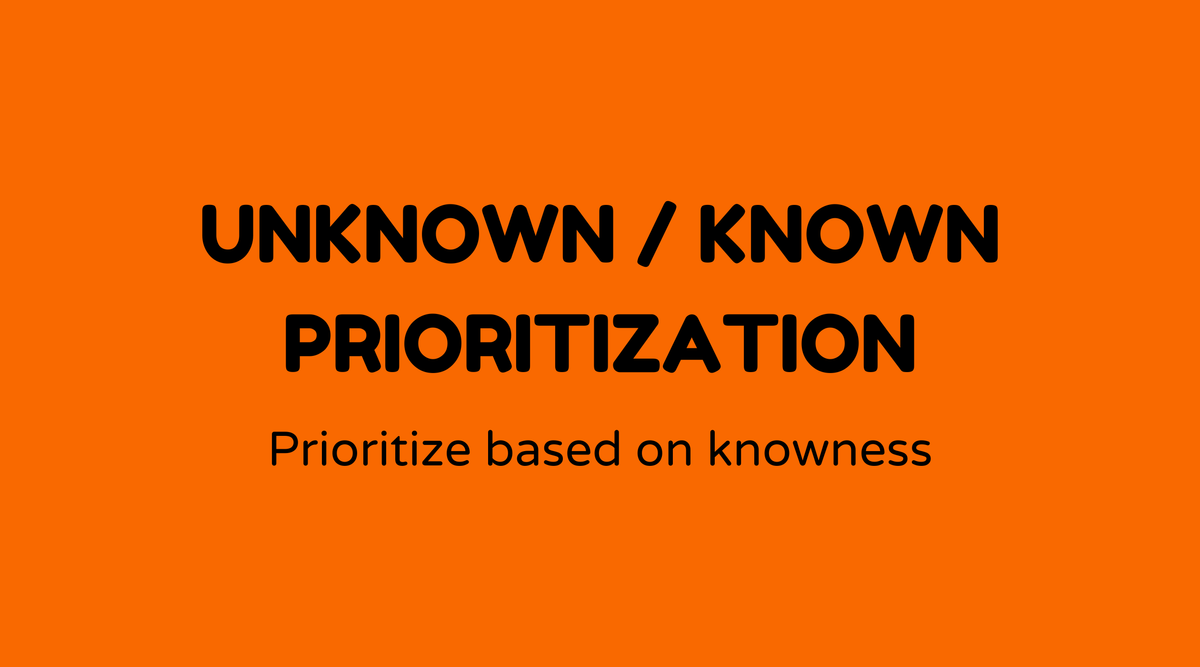Unknown / Known Prioritization

Overview of Unknown / Known Prioritization Workshop:
In today’s swift-paced environment, effective decision-making is essential, particularly during the product development process. This is where the Unknown / Known Prioritization Workshop becomes valuable. This workshop assists teams in categorizing and prioritizing tasks, ideas, and challenges by differentiating between what is known and what is yet to be discovered. It serves as an important step in straightforward decision-making, ensuring resources are utilized efficiently. Recognizing what you know versus what you don’t can determine whether a goal is achieved or if progress is stalled by uncertainty.
Why Unknown / Known Prioritization Matters:
Grasping the relationship between the known and the unknown helps to streamline processes and enhance decision-making. This workshop enables teams to concentrate on resolving issues without becoming mired in uncertainties. By distinguishing facts from uncertainties, teams can wisely allocate resources, innovate swiftly, and sidestep potential setbacks. Consequently, the project proceeds smoothly, and the team maintains productivity.
Furthermore, identifying these areas mitigates the risks associated with product failures, budget excesses, and missed opportunities. It establishes a pathway for proactive management while improving the responsiveness to new information.
What is Unknown / Known Prioritization:
The Unknown / Known Prioritization method focuses on sorting tasks or projects into what is already understood (known-knowns) and what requires further investigation (unknown-unknowns or known-unknowns).
- Known-Knowns: These aspects of a project are understood and certain.
- Known-Unknowns: Tasks that present identifiable gaps in knowledge that require addressing.
- Unknown-Unknowns: Unexpected issues or tasks that become apparent only after they arise during the project.
This approach does not only clarify ambiguity but also cultivates a more structured and data-driven method for tackling projects.
How to Conduct an Unknown / Known Prioritization Workshop:
Facilitating an Unknown / Known Prioritization Workshop necessitates careful planning and engagement from all participants. Here’s a step-by-step guide:
-
Preparation:
- Define the goals of the workshop.
- Collect relevant data and ensure all attendees are familiar with the current context.
-
Initiation:
- Commence with an explanation of unknown/known prioritization.
- Establish clear rules for discussion.
-
Categorization:
- Utilize a whiteboard or a digital tool to list all items.
- Accurately place each item into Known-Knowns, Known-Unknowns, and Unknown-Unknowns.
-
Prioritization:
- Discuss and determine priority based on impact and ease of resolution.
- Allocate resources and establish deadlines.
-
Action Plan:
- Document the outcomes and assign responsibilities.
- Schedule follow-ups and review meetings to assess progress.
Sample Agenda of Unknown / Known Prioritization Workshop:
-
9:00 AM - Introduction
- Overview of goals
- Brief on known/unknown concept
-
9:30 AM - Categorization Session
- Group discussion
- Separate into three categories
-
10:30 AM - Prioritization Exercise
- Assign priorities to tasks
- Determine strategy and resource allocation
-
11:30 AM - Action Planning
- Develop action plans
- Set responsibilities
-
12:00 PM - Review & Feedback Session
- Review decisions
- Gather feedback for improvements
Examples of Unknown / Known Prioritization:
- Product Development: A tech company organizes R&D ideas based on existing capabilities and knowledge gaps.
- Project Management: A construction project identifies established safety regulations and uncertain environmental impacts.
- Healthcare: A hospital plans according to known patient data and unpredictable disease progressions.
FAQs
What are the benefits of conducting this workshop?
- It establishes clear action plans, aligns teams on priorities, and reduces risks.
How do you manage unknown-unknowns in a project?
- Stay adaptable; use methods like brainstorming or simulations to bring these unknowns to light.
How often should such workshops be conducted?
- Regularly during key phases or when noteworthy new information arises.
Can these techniques be applied to personal projects?
- Certainly, understanding and forecasting actions can enhance personal task management too.
What's the difference between known-unknowns and unknown-unknowns?
- Known-unknowns are gaps you recognize; unknown-unknowns are surprises that catch you off guard.
What tools can aid in these workshops?
- Tools like Trello or Miro can facilitate collaboration and visualization.



